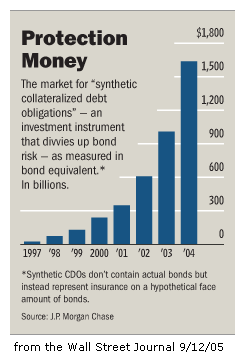

|
| weblog/wEssays | home | |
|
Is Risk Being Eliminated, or Merely Increased? (September 16, 2005) 
A front-page article in the September 12, 2005 Wall Street Journal outlines how mathematical formulas are employed at the highest levels of finance to reduce risk via trading derivatives. The technique is widely used to lower risks in portfolios of stocks, bonds, currencies and commodities as a form of "insurance:" if one part of the portfolio tanks, then the derivative "insurance" (actually a bet in the opposite direction) rises in value, offsetting the loss. Being financial instruments based on other financial instruments rather than on something with intrinsic value such as a bond or share of stock, derivatives are hard to grasp. Owning a derivative is not the same as owning an actual bond or stock, and as such they can be created out of thin air by financial institutions. The WSJ article describes how a new algorithm has spurred the rapid growth of bond and mortgage derivatives (see chart). The piece goes on to note that despite the stated goal of lowering risk, the derivatives have the potential to trigger a cascade of financial mayhem should things go wrong. The person who devised the new formula, David Li, says of it: "It's not the perfect model, but there's not a better one yet." This begs the question: how good is any model? The answer can be found in a seminal if generally overlooked book by mathematician Benoit Mandelbrot, he of fractal geometry fame, entitled The Misbehavior of Markets. Suspecting that markets may follow a fractal pattern, Mandelbrot examined the "standard model" of portfolio risk management (that is, the one using derivatives as insurance) and found that these standard models did not match the actual behavior of markets. More specifically, they made no allowance for the rapid, sudden swings up and down which are inherent in fractal geometries and actual market behavior. The odds of a sudden fall-off are tiny in the standard model, yet in real life huge drops occur with startling regularity: the Asian Criss of 1997, the Russian Default crisis of 1998, 9/11/01, and so on. The takeaway from Mandelbrot is simply this: the standard model of portfolio risk management completely underestimates the risk of sudden, violent downturns in markets. Interestingly, the WSJ article highlights a "close call" of just the type unanticipated by the standard model. A downgrade of GM bonds last year nearly triggered a meltdown in the bond derivative market, as the model ties all sorts of bond risks together in a chain of "tranches," or degrees of risk sold to different investors. In other words, the story of this new model and the near-collapse of the derivatives it has spawned suggests that Mandelbrot is correct: the risks that are built into the "standard model" are far higher than generally recognized, and that periodic eruptions of risk have the potential to take the entire system down. Note that the derivatives based on just this one slice of the market already exceed $1.5 trillion. The size of the entire derivatives market is estimated at $10 trillion, or about the size of the entire U.S. GDP. The potential losses if such a mountain of derivatives should fall are similarly huge. We have a friend, obviously a very smart person, who trades currencies in New York for one of the large global banks which collectively trade over $1 trillion in currencies each and every day. I once asked him: What's your dollar limit on currency bets? $10 million? $100 million? He shook his head and smiled slightly. There is no limit, he replied. I might own $10 billion or even $100 billion in a currency for a few minutes or hours. There aren't many such traders in the world--perhaps only a few hundred--but if you add the other big traders in bond and stock derivatives and options, you get a picture of just how much money changes hands in the world financial markets every day, and how quickly an unanticipated "event" could bring the entire supposedly "risk-free" edifice crashing down. * * * copyright © 2005 Charles Hugh Smith. All rights reserved in all media. I would be honored if you linked this wEssay to your site, or printed a copy for your own use. * * * |
||
| weblog/wEssays | home |